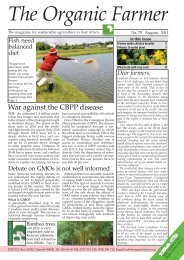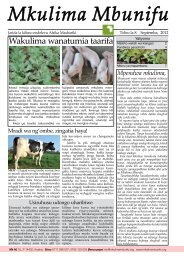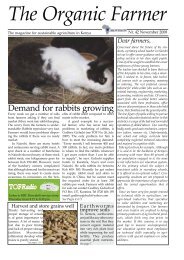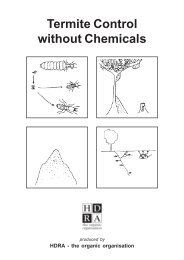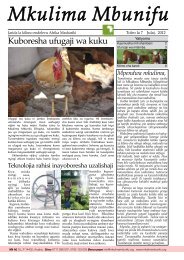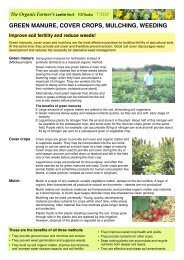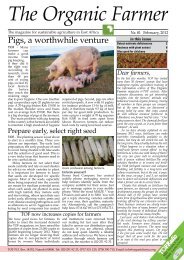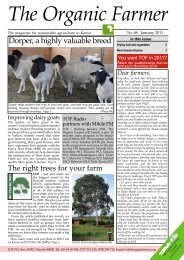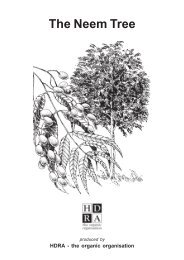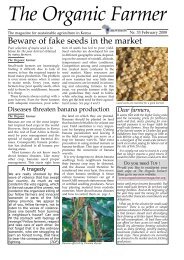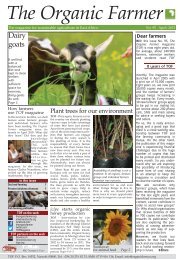4 Organic crop nutrition 29.3.2010 - Infonet-Biovision
4 Organic crop nutrition 29.3.2010 - Infonet-Biovision
4 Organic crop nutrition 29.3.2010 - Infonet-Biovision
You also want an ePaper? Increase the reach of your titles
YUMPU automatically turns print PDFs into web optimized ePapers that Google loves.
The <strong>Organic</strong> Farmer’s Leaflet No 4TOFRadioORGANIC CROP NUTRITIONHow natural plant <strong>nutrition</strong> worksGreen plants are able to photosynthesize: with sunlight, carbon gas and water they produce sugars, which theylater transform to plant matter. Humans and animals can obtain nutrients only by consuming and digesting plants(or animals which feed on plants).Both plants and animals also require minerals. Humans and other animals extract them from the food they eat.Plants take up minerals and other useful compounds from the soil solution which surrounds their roots. Theydepend on the processes of the soil ecosystem where millions of micro-organisms are constantly busy withfeeding from organic and inorganic matter in the soil while breaking it down and converting it chemically. Some ofthe resulting compounds and byproducts, like nitrate, ammonium, or phosphates, but also a whole range of otherminerals are taken up by the plant roots for use in the plant.<strong>Organic</strong> nutrient management: “Feed the soil and not the plants”The organic philosophy of <strong>crop</strong> <strong>nutrition</strong> is to takeproper care of soil organisms, because they areresponsible for the processes on which plant<strong>nutrition</strong> has always relied. <strong>Organic</strong> farmers believethis is best accomplished by feeding the soilorganisms with organic matter and natural rockminerals, and by avoiding toxic chemicals andpractices that are harmful to the soil creatures.<strong>Organic</strong> producers have to maintain and improvethe soil they manage and have to replenish what isharvested. Management by neglect is not acceptedas organic - it is not sustainable as soils will getpoorer and poorer.Soil fertility is regenerated by using and recyclingrenewable resources from plant and animal originwhich add organic matter to the soil. <strong>Organic</strong> matteris central to soil fertility: it binds and stabilizesnutrients, promotes biological activity, improves soilstructure, regulates soil acidity, enhances waterinfiltration and drainage, and decreases erosion.<strong>Organic</strong> matter is especially important for very poorsoils where mineral fertilizers are not efficientbecause of poor nutrient retention.rock mineralsrocksunlightplantlitternutrientsfaecesdeadmanurebodiessoil creatures organisms &fungi micro-organismsmicro-organisms(fungi, bacteria)Inorganic fertilizersCommercial inorganic fertilizers provide nutrients to theplant directly, in soluble and highly concentrated form.They are available to the plants immediately. <strong>Organic</strong>farmers have reservations about this approach:• Mineral fertilizers do not support soil biotic life, butmay actually reduce it if they are applied withoutaddition of organic matter over a long period. Manyinorganic fertilizers also increase soil acidity, creatinga hostile environment to plants. As a result, soils andplants may become increasingly dependent onsynthetic inputs and if they are not providedconstantly, yields will decrease.• Soluble nutrients, especially nitrate, are easily washedout by leaching and may create environmentalproblems like contamination of ground water.• Flooding the plants two or three times with highamounts of only two or three important nutrients maycreate imbalances in the plants leading to reducedresistance against diseases and insect attacks.<strong>Organic</strong> fertilizersIn organic farming, fertilizers have to be of natural origin.Fertilizers from recycled plant and animal material(livestock manures, green manures, composts) are lessconcentrated than mineral fertilizers and contain highamounts of organic matter. Before their nutrients can betaken up by plants, organic matter has to be brokendown by micro-organisms; nutrients are thereforereleased slowly and over longer time. This also meansthat they are sometimes not available in the quantityrequired by some <strong>crop</strong>s.Breakdown of organic matter is speeded up by:• Tillage, as this adds oxygen so the soil.• Addition of nitrogen, as this allows the soil organismsto multiply and to be more active.• Moisture, as water is required for all biologicalprocesses.The most common fertilizers used in organic agricultureare described in the next sections.
Livestock manureLivestock manures have been a primary source of nutrients and soil organic matter for hundreds and thousands ofyears. They are the most widely used organic fertilizers. It is strongly encouraged in organic farming that livestock isintegrated into the farm operation and manuring is part of a system where nutrients are continuously recycled.Nutrient content of manuresThe amount of nutrients in manure from different animals canvary widely and are very dependent on handling methods.Especially nitrogen content decreases over time. Nitrogen canbe quickly lost to the atmosphere and is easily washed out byrain. To avoid nutrient losses, cover manure and compostheaps, and apply manure when the soil is moist, and work itin superficially. For average contents of main nutrientsprovided by different animal manures see Table 1 on page 4.Fresh manure includes risksManure includes some health and environmental risks, as itcontains relatively high levels of human, animal and plantpathogens. Soluble and volatile nutrients may cause waterand air pollution, and it may also contain weed seeds,parasites, and veterinarian drugs. Fresh manure and urinecan also “burn” plants due to high ammonium content.Farmers can protect people and the environment from theserisks. This is what you can do:• Compost animal manures and urine before application.• If you apply fresh manure, keep an interval of at least twomonths between manure application and harvest of <strong>crop</strong>sfor human consumption.• Use fresh manure only in moderate amounts and spread ituniformly and superficially.How much manure do you need to fertilizeone acre?A nice rule of thumb is that one dairy cow and hercalf produce just around the amount of manure tofertilize one acre planted with Napier grass oranother common <strong>crop</strong> like maize or potatoes peryear. This is around 15 tons of manure per year - ifyou collect all the manure continuously.Note: Your cow and calf need around one acreplanted with fodder for their own <strong>nutrition</strong> –and this acre should also be fertilized! To putit bluntly: Animals provide enough manure tofertilize their own fodder, but there will not bemuch left for other <strong>crop</strong>s!YEP!HERE WE GO!Composting of manuresOne of the best means of handling manures is composting.Composting stabilizes the nutrients in manure and makesthem more available to plants. Composting reducespathogens as well as livestock parasites, and buildspopulations of beneficial organisms. Composted manure hasa highly beneficial effect on soils and <strong>crop</strong>s.MANURE COMPOSTALWAYS TWOTOGETHER,PLEASE!Leguminous green manures –the most efficient nitrogen providersGreen manures and cover <strong>crop</strong>s are a majorsource of organic matter and nutrients, and theyprotect the soil from erosion and crusting.Green manures are grown during the off-season orcan be inter<strong>crop</strong>ped with a main <strong>crop</strong>. They can becut or grazed to feed animals. They are workedinto the soil or left as mulch to decay and toprovide nutrients before the next <strong>crop</strong> is planted.Suitable plant species have deep root systems thatbring nutrients up to the soil surface and aretolerant of drought or nutrient stress. For moreinformation please refer to our leaflet No 6 “Greenmanures, cover <strong>crop</strong>s, mulching, weeding”.High nitrogen fixation ratesThe most important green manures and cover<strong>crop</strong>s are leguminous plants that together withbacteria are able to capture nitrogen from theatmosphere to build up plant material. When theydecay, this nitrogen can be used by the next <strong>crop</strong>sfor their growth.Nitrogen fixation rates can be between 15 to 80 kgN per acre! Green manuring is therefore the mostefficient way to provide nitrogen to your farm and toreplace synthetic nitrogen fertilizer.Rock phosphateRock phosphate is (after compost) the most widely appliedphosphate source in organic farming.The phosphorus from rock phosphate is released more easilyin moderately acidic soils, and long-term benefits are higher.Rock phosphate usually contains calcium as well and reducessoil acidity when it dissolves in the soil. P is released slowlyand stays in the soil for many years.Rock phosphate should always be added to compost ormanure, as a natural acidification process caused by organicmatter and the activity of some specialized fungi increaseavailability of phosphorus. When rock phosphate is mixed intocomposts in generous amounts while setting up the heap, itshould become available to plants in most soils.Not all <strong>crop</strong>s respond in the same way: Legumes and milletsrespond best and directly to addition of rock phosphate,whereas on maize the effect may be only long term.Recommended application rates• Generally, use 50 - 150 kg per acre and per year• To fertilize one acre, mix 100 kg rock phosphate with 4 tonsof farm yard manure.Minjingu rock phosphate has about 0-30-0.• Per planting hole, mix one spoonful of rock phosphate with 2to 5 handfuls of manure or compost and work them well intothe topsoil. Take care not to inhale the powder.
GOT TO TEST MYNEW DIVINGEQUIPMENT!NICECOUNTRYSIDE, THIS!Supplemental fertilizationCrop rotation, manuring, green manures, cover <strong>crop</strong>sand composts provide an abundant supply of minerals.Supplemental fertilization can be beneficial ornecessary in specific situations, but for poor soils andfor soils that have been heavily exploited for manyyears, a serious soil-building programme with greenmanures and cover <strong>crop</strong>s that increase soil organicmatter should always have first priority.CompostCompost is a very good source of organic matter andsome nutrients, particularly for smaller farms. It is anideal phosphorus provider when mixed with rockphosphate. Compost is very low in nitrogen comparedto a synthetic nitrogen fertilizer. But it is most essentialas it supplies organic matter and improves soil fertility.In mature compost, nutrients are stable and theirsolubility is decreased. Weed seeds and soil borndiseases are also decreased. It is almost impossible toproduce and to use too much compost on the farm;compost is always a scarce resource!AshesBYE!Wood ash is a good source of calcium and potassiumcarbonate. It can be mixed into compost. Ashes raisesoil pH (reducing acidity). However, if very largequantities are applied repeatedly, this can have anadverse effect on soil structure.Foliar FeedsFoliar feeds provide nutrients to plant leaves and stemsand are absorbed there. Commercial foliar feeds areusually soluble fish or seaweed-based products orhumic acid extracts, while teas (liquid manures) arewatery extracts from plants, manures, or compost andcan be produced on farm.Foliar feeding can provide some nutrients when theyare needed urgently. They usually provide some quicknitrogen. Foliar fertilization also seems to stimulate theroots and biological activity in the root zone.Mineral supplementsSupplementing important minerals such as calcium,magnesium, copper, iron, and others should only bedone after soil testing. <strong>Organic</strong> farmers are encouragedto have their soils tested for deficiencies of all majornutrients and minerals from time to time!Always do a comparison to test new products!A wide range of further products like humates, humicacids, enzymes, catalyst waters, bio-activators, orsurfactants are commercially available. Their efficacyis often unclear. <strong>Organic</strong> farmers are encouraged totry them - but always compare a new input with a“check”! This means you should not treat more thanhalf your field with a new remedy, and in the end youshould compare the yields with the yields from thepart of the field which you just treated normally!More about nitrogen (N)Nitrogen deficiency causes uniform yellowing of olderleaves, progressing upward in the plant. In young plants,nitrogen deficiency causes the whole plant to be pale andyellowish green with weak stems.All forms of nitrogen which can be taken up by plants andwhich are found in the soil or in fertilizers tend totransform and to disappear. They can be washed out withwater in the form of nitrate, or they go into the air asammonia and nitrogen gas (N 2 ). See the illustrations!This is why compost and manures should not be exposedto sun and rain and should be worked into the topsoil.They should be used as soon as they are applicable, astheir nitrogen content diminishes steadily.available to the plant. As a result, organic <strong>crop</strong>s mayhave slower growth rates, and sometimes less lushgreen vegetation.You may now also see why leguminous species are soimportant: they convert the nitrogen they catch from theair into recyclable plant material.HEHE! THEYHAVE TO FEEDMY CROPS FIRST.<strong>Organic</strong> farming and nitrogenNitrogen management is probably the greatest challengein organic farming. Nitrogen is mainly recycled from twosources: from nitrogen-fixing green manure plants andfrom animal manure which is usually composted.Composting recycles and stabilizes at least a part of thenitrogen which is present in all plant materials and animalmanures. Nitrogen applied in this way is more stable andless likely to leach or volatilize, but it is also not as readilyTHOSE NITROGEN GUYSCAN TAKE THEIR HOLIDAYS LATER!I’LL LODGE ACOMPLAINT!
Phosphorus (P)Phosphorus is absolutely essential for both plants and animals as anenergy carrier and for growth and reproduction, flowering and fruiting.Deficiency is rather difficult to identify. Plants are dwarfed or stuntedand develop only very slowly. Stems and the under sides of theleaves may become purple.In healthy soils rich in organic matter, special fungi attaching to theroots help the plants to extract phosphorous from the soil. P does notget lost as easily as N.Potassium (K)Potassium deficiency starts with browningdry leaf tips on older leaves, and later thespaces between the veins get yellow, whilethe veins still remain green. The leavesmay start curling up.African soils often do not have largeamounts of potassium, as it easily washesout with rain.Table 1: Nutrient contents of common organic fertilizersNitrogen Phosphorus (P 2 O 5 ) Potassium (K 2 O)• Leguminous <strong>crop</strong>s that are used as green manures oras mulch provide between 20 to 80 kg N / acre whichcan be used by subsequent <strong>crop</strong>s.• Blood meal / feather meal 12-15% N. They are applieddirectly to the <strong>crop</strong>s.• Urines from all species contain pure urea (up to 1% N).It is not a stupid idea to urinate on the compost heap!• Poultry manure 8-20 kg N/t• Pig manure 3-5 kg N/t• goat / sheep manure 2-4 kg N/t• cattle manures 2-3 kg N/t• Compost * 1 kg N/t• Manure teas and plant teas provide easily availablenitrogen and can be used as top dressing or foliar feeds• rock phosphate 20-33%• bone meals 12-25%• poultry manure 10-25 kg/t• pig manure 3-6 kg/t• goat/sheep 2.5-4 kg/t• cattle manure 2-3 kg/t• compost * 4 kg/t• wood ash 3-7%• goat / sheep manure 12 kg/t• cattle manure 5-12 kg/t• poultry manure 5-12 kg/t• compost * 6 kg/t• pig manure 3-7 kg/t• urines: 1-3 kg/t* Content of purely vegetative compost. If compost is preparedwith livestock manures, rock phosphate and wood ash, theproduct will have higher nutrient contents.Nutrient contents of manures and composts are highlydependent on handling and storage and on feed quality!Is organic <strong>crop</strong> <strong>nutrition</strong> the solution?It can not be denied that the situation of farmers in Kenyaand other African countries seems severe. In contrast tomost developing countries on other continents, per capitafood production is declining and among the lowest in theworld.Many reasons for this have been identified. Lack ofgovernmental support and investments are one thing.Another thing is the drastic population increase within fewdecades, and pressure on land leading to deforestation andsoil depletion. In a tropical climate where organic matterdecomposition is fast, continuous <strong>crop</strong>ping can have severeconsequences. Soils are more vulnerable, as nutrientsleach out easily and erosion rates can be high. Water canbecome scarcer as retention in the soil is decreased.Together with the ongoing climate change, this is fatal. Thesubsidies for mineral fertilizers between 1960 and 1985improved <strong>crop</strong> productivity to some extent, but not soilquality. When African governments stopped the subsidies,many farmers were already sitting on degraded <strong>crop</strong> land.Nowadays, small-scale farmers can hardly afford anyfertilizers, with the result that the soil-mining goes on.Poor seed quality and low-yielding <strong>crop</strong> varieties arefurther problems. But the potential of improved <strong>crop</strong>varieties cannot be realized on nutrient-depletedsoils! Together with poor water management, this isthe main reason why their contribution to <strong>crop</strong> yieldincreases has been very low in Africa.What can farmers do in a situation which seems sohopeless? We do not promise you that organicfarming is the solution to everything. But it is certainlyan essential part of the solution. Improving soilproductivity starts with building soil fertility andcareful resource management. Many people thinkthat combining organic and conventional techniquesis the most promising way forward. Negative effectsof conventional methods should be avoided byrestricted and clever use of synthetic inputs, whileboth methods contribute to increased production.You should also know that increasing soil organicmatter takes many years. But in the long run, there isactually no other choice, if soil depletion is to bestopped. It is better to start now!Publication of The <strong>Organic</strong> Farmer. The magazine for sustainable agriculture in Kenya. www.organicfarmermagazine.orgP.O. Box 14352, 00800 Nairobi. Tel: 020 44 50 398. Email: info@organickenya.orgAuthor Theresa SzekelyReferences TOF magazine; <strong>Infonet</strong> biovision: www.infonet-biovision.orgG. Kuepper and L. Gegner, 2004: An Overview of <strong>Organic</strong> Crop Production. Sponsored byhttp://www.attra.ncat.org/attra-pub/organic<strong>crop</strong>.htmlBrian Baker undated: <strong>Organic</strong> Practice Guide.http://www.sarep.ucdavis.edu/organic/complianceguide/organicguide.pdfJohn A. Biernbaum undated: <strong>Organic</strong> Farming Principles and Practices.http://www.msuorganicfarm.com/organicfarmingprinciplesandpractices.pdfS. M. Obaga et al. 2005: Minjingu Rock Phosphate. KARI – KISII



